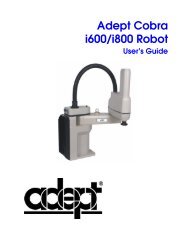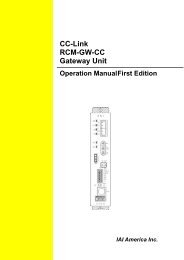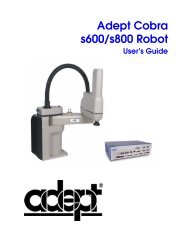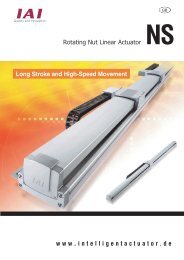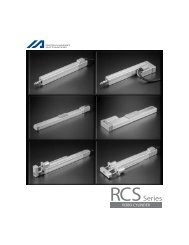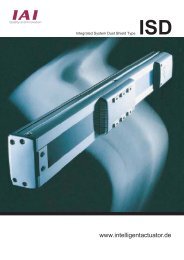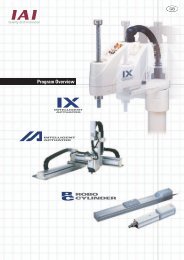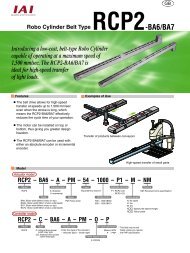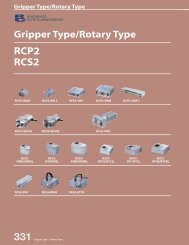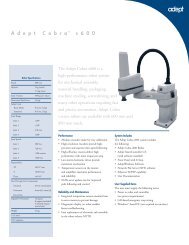Download Adept Cobra PLC600 User's Guide - pulsar.com.tr
Download Adept Cobra PLC600 User's Guide - pulsar.com.tr
Download Adept Cobra PLC600 User's Guide - pulsar.com.tr
Create successful ePaper yourself
Turn your PDF publications into a flip-book with our unique Google optimized e-Paper software.
PLC Software Overview<br />
Current Motion Counter<br />
The Current Motion Counter (N241:2 or <s<strong>tr</strong>ong>Adept</s<strong>tr</strong>ong>_Current_Motion_Counter) is incremented<br />
each time a motion begins. It can be used to determine that the previous <s<strong>tr</strong>ong>com</s<strong>tr</strong>ong>manded<br />
motion has started and the next motion parameters can be loaded into the <s<strong>tr</strong>ong>com</s<strong>tr</strong>ong>mand<br />
registers. This gives the optimum continuous-path performance. Without this counter, the<br />
programmer would need to handshake with the <s<strong>tr</strong>ong>com</s<strong>tr</strong>ong>mand-executing bit to determine<br />
when a motion has started, which would in<strong>tr</strong>oduce delay into <strong>tr</strong>ajectory planning.<br />
NOTE: If your program is using this counter in conjunction with a timer<br />
or other event, you must turn off the latch bit. Otherwise, the program<br />
could read position registers during an update, which could result in<br />
corrupted data.<br />
Current Position Array<br />
The following table describes the Current Position array.<br />
Table 6-10. Current Position Array<br />
RSLogix 500 RSLogix 5000 Description<br />
F244:0 <s<strong>tr</strong>ong>Adept</s<strong>tr</strong>ong>_Here.0 Current X-axis coordinate<br />
F244:1 <s<strong>tr</strong>ong>Adept</s<strong>tr</strong>ong>_Here.1 Current Y-axis coordinate<br />
F244:2 <s<strong>tr</strong>ong>Adept</s<strong>tr</strong>ong>_Here.2 Current Z-axis coordinate<br />
F244:3 <s<strong>tr</strong>ong>Adept</s<strong>tr</strong>ong>_Here.3 Current Yaw-angle coordinate<br />
F244:4 <s<strong>tr</strong>ong>Adept</s<strong>tr</strong>ong>_Here.4 Current Pitch-angle coordinate<br />
F244:5 <s<strong>tr</strong>ong>Adept</s<strong>tr</strong>ong>_Here.5 Current Roll-angle coordinate<br />
F244:6 <s<strong>tr</strong>ong>Adept</s<strong>tr</strong>ong>_Here.6 Current Joint-1 position<br />
F244:7 <s<strong>tr</strong>ong>Adept</s<strong>tr</strong>ong>_Here.7 Current Joint-2 position<br />
F244:8 <s<strong>tr</strong>ong>Adept</s<strong>tr</strong>ong>_Here.8 Current Joint-3 position<br />
F244:9 <s<strong>tr</strong>ong>Adept</s<strong>tr</strong>ong>_Here.9 Current Joint-4 position<br />
F244:10 <s<strong>tr</strong>ong>Adept</s<strong>tr</strong>ong>_Here.10 Current Joint-5 position<br />
F244:11 <s<strong>tr</strong>ong>Adept</s<strong>tr</strong>ong>_Here.11 Current Joint-6 position<br />
When teaching locations, it is up to the programmer or system developer to create a<br />
method for storing that data, for example, in a data table. (That is, the data s<strong>tr</strong>ucture for<br />
storing the taught locations in the PLC is up to you.) Then, when moving the robot to one<br />
of those locations, the data must be moved from the data table into the <s<strong>tr</strong>ong>Adept</s<strong>tr</strong>ong> Location<br />
registers (F242:0-5 or <s<strong>tr</strong>ong>Adept</s<strong>tr</strong>ong>_Location.0-5) or, if using a pallet, a <s<strong>tr</strong>ong>com</s<strong>tr</strong>ong>bination of the <s<strong>tr</strong>ong>Adept</s<strong>tr</strong>ong><br />
Location registers (F242:0-5 or <s<strong>tr</strong>ong>Adept</s<strong>tr</strong>ong>_Location.0-5) and the <s<strong>tr</strong>ong>Adept</s<strong>tr</strong>ong> Pallet registers<br />
(F243:0-5 or <s<strong>tr</strong>ong>Adept</s<strong>tr</strong>ong>_Pallet.0-5).<br />
<s<strong>tr</strong>ong>Adept</s<strong>tr</strong>ong> <s<strong>tr</strong>ong>Cobra</s<strong>tr</strong>ong> <s<strong>tr</strong>ong>PLC600</s<strong>tr</strong>ong>/PLC800 Robot User’s <s<strong>tr</strong>ong>Guide</s<strong>tr</strong>ong>, Rev B 93



